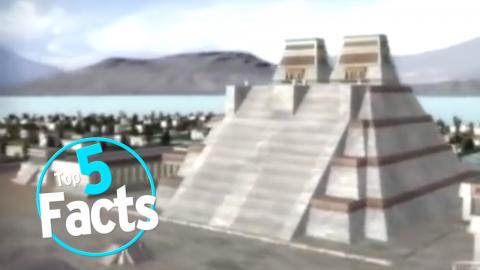Top 5 Facts about Aztecs

They were once one of the world's greatest empires, but they don't seem to receive the same publicity as the British or Romans. Welcome to http://www.WatchMojo.com Top 5 Facts. In this instalment, we're counting down the most fascinating and surprising facts about the Aztec Empire, which dominated significant portions of Mesoamerica during the 14th to 16th centuries.
Special thanks to our user christo for submitting the idea on our Interactive Suggestion Tool at http://www.WatchMojo.comsuggest
#5: We’re Still Using Aztec Words Today
The Aztecs spoke the Nahuatl language, and you may be surprised to know that there are several words in English that actually have an Aztec background. Did you ever own a chia pet? The word chia, which is the common name for the plant species salvia hispanica, comes from the Nahuatl word chian, which means oily. Maybe you’re a Minecraft fan and love to tame any Ocelot you find. Well, Ocelot comes from the Nahuatl word tlatlocelotl, which means “field jaguar”. We bet Tony Soprano had no idea he had the Aztecs to thank for his peyote trip, as the name for the hallucinogenic drug comes from the Nahuatl term peyotl . There are several other English words that come from the Aztec language, including tomato, avocado, guacamole, and even chocolate!
#4: Many Were Done in by Disease
Most people will tell you that the Aztecs were conquered by Hernán Cortés and his Spanish Conquistadors in the early 16th century. Most people would miss a big part of the story. While it’s true that Cortés and Spanish imperialism were responsible for the decline of the Aztec empire, disease played a major role decimating the Aztec population. The Aztecs had no experience with European diseases, and as such had no immunity to them. An outbreak of smallpox in 1520 is said to have wiped out nearly half the population of Tenochtitlan, the empire’s capital. That significantly reduced the strength of the Aztec forces, while leaving the more disease-resistant Spanish forces intact.
#3: They Fed Humans to the Gods to Keep Them Strong
The Aztec gods had quite the appetite, and the only thing that could satisfy them, at least in the minds of the Aztec people, was more humans. The Aztecs believed that gods needed blood and human hearts for nourishment, and so sacrifice was performed by cutting open the victim’s chest and removing their heart. The Aztec worship schedule was very rigid and was regulated by two calendars, with individual gods ruling particular weeks, days, and even hours. Each month was dedicated to one of the major gods, and all human sacrifice during that month ensured that the particular god remained nourished and strong.
#2: They Had a Structured System of Slavery
The Aztecs had a very structured society, which included a division between the common people, or the macehualtin, and the nobles, or the pipiltin. Of course, there was also a third group – the slaves, or tlacotin. Slaves consisted of a wide variety of people, including criminals, but usually they were poor people who exchanged their freedom for something like food or shelter. Unlike in Europe or later America, however, Aztec slavery was not hereditary, meaning that a slave’s children were free. Masters were not allowed to sell their slave without first gaining their consent and needed to treat their slaves kindly, as slaves who were mistreated were granted their freedom.
#1: Their Capital Was a Massive City in a Lake
A great empire is nothing without an awesome capital. The British had London, the Romans had Rome, and the Aztecs had Tenochtitlan. When Cortés arrived in the early 16th century, it is estimated that well over 200,000 people lived there, making it the largest city in Mesoamerican history and one of the largest in the world at the time. Situated in middle of Lake Texcoco, Tenochtitlan was connected to the mainland by a series of causeways and bridges that allowed for water traffic. The city also contained a series of canals that allowed access via land or water. In the middle of the city was the palace, which had an aquarium, two zoos, a botanical garden, and 100 rooms, each with its own bath.
So, do you wish you could have visited Tenochtitlan, or do you prefer to live in an age where we aren’t sacrificed to feed the gods? Gracias to Fernando for his help today.
And for more epidemic proof Top 10s and sacrifice worthy Top 5s, be sure to subscribe to WatchMojo.com.
